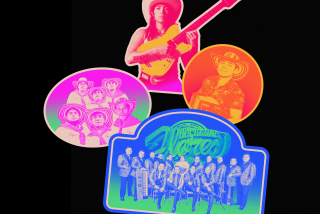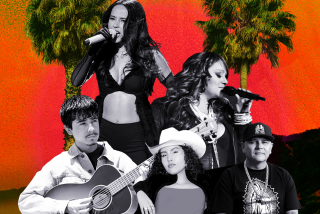Calentana comes alive in his hands
RIVA PALACIO, Mexico — Don Juan Reynoso looks tired. After three wives, 18 children and 92 years of hard living, you probably would too. But being tired is one thing. Being finished is another.
Outside Reynoso’s single-story home, the midday sun is hammering the dusty streets of the Tierra Caliente, the fabled “hot lands” of west-central Mexico. It’s an ideal time for a siesta, and Reynoso, slumped in his living-room sofa, appears to be drifting toward oblivion.
But what’s this? Someone has just stuck a bow and fiddle in Reynoso’s gnarly hands. Like a man slowly waking from a dream, the maestro takes his stick and slices it across the strings, drawing out the achingly earnest notes of “Lazos de Amor” (Bonds of Love).
Reynoso’s face is impassive and, apart from his arms, his body barely moves. But there’s no mistaking the old man’s rapturous concentration, the depth of his connection to this eccentric, fiercely emotional music. It’s hard not to agree with his manager, Lindajoy Fenley, 56, who says that if Reynoso -- the greatest living master of calentana music -- weren’t still playing, “he would be dead.”
In fact, not long ago many Mexicans thought that Reynoso was dead, and that calentana culture -- named for the Tierra Caliente -- already had one foot in the grave. That makes it all the more surprising to learn the story of what Fenley calls Reynoso’s “resurrection” over the last dozen years: a handful of new recordings and reissues; regular showcases in Mexico City and other cultural hotspots; a few U.S. and Canadian concert appearances, including nine straight years at the Festival of American Fiddle Tunes in Port Townsend, Wash.; and scads of tributes and awards from Mexican politicians, among them the prestigious Premio Nacional.
Even more than his technical skill, it’s the sheer ardor of Reynoso’s playing that can make listeners gasp out loud. “He takes out the violin and he attacks it like a hyena ripping into a lioness,” says Paul Anastasio, 51, a Seattle-area violinist and music instructor who caught the calentana bug in the late 1990s and now makes annual pilgrimages here to study with Reynoso. He and Reynoso also have transcribed more than 500 musical charts of Reynoso’s violin fingerings to help make them available to a wider audience and to establish some degree of copyright control over his core repertoire.
Government support
Meanwhile, calentana music, if not quite a full-blown Lazarus act, does appear to be enjoying a modest revival on both sides of the border. More young musicians are taking up the instruments of their ancestors. Mexico’s national arts council has launched a one-year stipend/scholarship program to encourage new compositions of traditional Mexican music, including calentana. The state government of Michoacan is actively promoting its musicians and recently made a new Reynoso recording. And several Mexican American musical groups include some music of the Tierra Caliente in their playlists.
Most telling, perhaps, is that a devout handful of American musicians and music students such as Anastasio are making their way south to study with Reynoso and about a dozen other graying calentana masters scattered across the region. Though these old men and their doggedly archaic music aren’t likely to become the next Buena Vista Social Club, their new foreign apostles hope they can help preserve calentana’s legacy. “Most of these guys can’t travel, so I’ve got to pick their brains while I can,” says Anastasio.
Like Reynoso, who was born in the small hill town of Santo Domingo, Coyuca de Catalan, in the state of Guerrero, around the start of the Mexican Revolution in 1912, calentana music is a paradox: parochial but worldly wise, raw yet debonair, especially in the hands of a man who has been playing it nearly his entire life.
Though less celebrated than other Mexican roots music, such as the son jarocho and huasteco of eastern Veracruz state, calentana is a complex, addictive stew of ingredients: traditional Spanish pase dobles mixed with Cuban danzon and tango, European waltzes, marches, minuets and polkas, and U.S. fox trot and swing influences that drifted across the border via radio or were brought here by touring big bands, often liberally spiced with African syncopation.
A traditional calentana ensemble consists of one or two violins, a thumping tamborita (“little drum”) and a guitarra panzona, also known as the tua, a stubby, fretless guitar with a round back, strung with goat gut. The resulting sound can be as fastidious as a Haydn string quartet or as rough and sensual as a midnight hootenanny in an Appalachian hollow. Its sweetly fatalistic themes are romantic yearning, time’s remorseless passage and nostalgia for one’s native land.
Angel Huipio, 61, who hails from a long line of guitar players, says that calentana expresses the insatiable will to live of the people of the Tierra Caliente, an insular, mountainous inferno that straddles Michoacan and Guerrero states. “It’s the form of the character of the people,” Huipio says. “The people get up very early, very ready to survive. And the music is very intense.”
Reynoso speaks little these days and communicates mostly through his violin. But it’s clear that he and his aging compadres are relishing the renewed attention. Though most never stopped playing in the privacy of their homes, at weddings and funerals or in the bars and cantinas that dot the area, they gradually had been shunted aside in favor of insipid American pop and clangorous rock en espanol.
“There’s a lot of noise, stereos and other things. In the past you heard the accordion. Now it’s all electronic,” laments Castulo Benitez de la Paz, 76, a wispily built, gold-toothed guitarist who has been playing with Reynoso for half a century.
Today, some of the musicians and their U.S. supporters dare to hope that the slowly evaporating pool of calentana culture will be able to replenish itself, at least for another generation. “When I first met Don Juan, he said, ‘This is yesterday’s music. Nobody cares,’ ” says Fenley. “He never says that anymore.”
Technique remains
Reynoso takes kidney medication now and needs thick glasses and a metal walker to get around. He has given up the heavy smoking and drinking that are a roving musician’s occupational hazards.
But he hasn’t lost his legendary technique. For a brief time many decades ago, Reynoso appeared to be on the verge of national stardom. As a young man in the 1940s, he took his violin and nimble fingers to Mexico City, snagged a regular radio gig and later made a couple of movies with screen goddess Estela Inda. In the 1930s, he even became a personal favorite of Mexico’s socialist president Lazaro Cardenas.
At length he returned home and for decades became a fixture in the local cantinas and at private parties. He made some recordings in the 1970s, but by then many of the old musicians were falling silent.
Fenley, who was raised in California, says that when she and a companion first came here in 1993 to search for Reynoso, mesmerized by a cassette recording that Fenley had found in a Mexico City flea market, “we didn’t know if he was alive.” After knocking on the door and explaining their quest to Reynoso’s third wife, Esperanza, they were soon ushered into the maestro’s presence.
Eventually, Fenley became Reynoso’s friend and later his manager, and he built a not-for-profit music festival around him, the Encuentro de Dos Tradiciones (Encounter of Two Traditions), featuring rotating folk and roots-music groups from Mexico and the United States and Canada. She also introduced Reynoso to the Fiddle Tunes festival, which is bringing him back to Port Townsend in July. Those events helped pave the way for several new regional calentana festivals.
Esperanza, who met her husband when she was 14 and he was in his late 30s, says that Reynoso misses his American friends when they go away and is always talking about his next U.S. concert trip. “They give him life, with their visits, with doing things he likes, [and] that they don’t forget him,” she says.
Death can come swiftly and violently in the Hot Lands. The area is famed for its corruption and drug trafficking, and the highway out of town is littered with sideswiped dog and cattle carcasses. “Curva peligrosa,” Reynoso murmurs to himself, “dangerous curve,” as he rides in the front seat of Fenley’s truck en route to a Friday jam session at the home of Rafael Ramirez, 84, a violinist who has known Reynoso forever. Huipio, De la Paz and the faithful Anastasio are also present, along with two other young Americans who’ve come to study with Reynoso for a few weeks, Tim Wetmiller and Jakob Breitbach. Breitbach says that Anastasio, his former teacher, had “been raving about this music down here, and I thought I’d better check it out before it’s gone.”
The air is warm and thick with the smell of roasting chicken. The old musicians are energized and in good humor, and for the next six hours they play and reminisce, pausing only for lunch.
But as the afternoon steals on, a darker mood settles over the music. At one point De la Paz sing-speaks the lyrics to a favorite song: “Do not fail me, my heart / Allow me to live awhile longer /
If Fenley is right, and a true calentana renaissance is underway, many years from now other musicians may gather together on a late afternoon. But to hear Reynoso and the old men of the Tierra Caliente play these songs is to hear this uncanny music as it cannot ever be heard again, the high-lonesome sound of survival, against harsh odds. “Do not weaken, my heart / Allow me to live awhile longer.... “
More to Read
The biggest entertainment stories
Get our big stories about Hollywood, film, television, music, arts, culture and more right in your inbox as soon as they publish.
You may occasionally receive promotional content from the Los Angeles Times.











